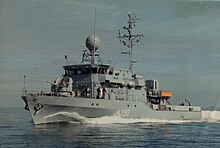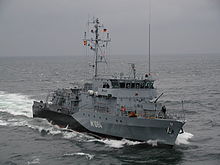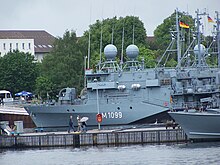Anti-mine vehicles of the German Navy
| Hameln class | |
|---|---|
 Grömitz (M 1064) after conversion with MLG 27 |
|
| Overview | |
| Type | Anti-mine vehicle |
| units | 28 |
| Shipyard |
Lürssen |
| Namesake | German cities and communities |
| period of service |
since 1989 Germany since 2005 Turkey since 2006 United Arab Emirates |
| Technical specifications | |
| displacement |
635-650 tons |
| length |
54.40 m |
| width |
9.20 m |
| Draft |
2.50 m |
| crew |
37-42 men |
| drive |
|
| speed |
18 kn |
| Range |
no information |
| Armament | |
| Sensors |
|
The various classes of anti-mine vehicles used by the German Navy since the end of the 1980s are based on a uniform ship design. The Turkey also procured boats from this type of ship. This article describes the different variants.
development
One of the first tasks of the German Navy was to remove the remains of mines from the Second World War in German waters. For this purpose, 24 clearing boats of the Capella and Aldebaran class were returned to Germany from their spoils of war . In fact, these boats with German crews under Allied control ( German Mine Clearance Service ) had been engaged in mine clearing tasks not only in German waters since the end of the war, and they formed the material and personnel basis of the mine defense associations. As a further development of this type of boat from the war, the fast minesweepers of the Schütze class were created , which were very similar to the clearing boats in design and properties.
During the East-West conflict , the German Navy was responsible for both mine deployment and mine defense. The first conceptual ideas when building the navy assumed that the German naval and sea air forces would have to prepare a large Allied landing in the rear of the opposing troops in the event of war. This required a large number of anti-mine vehicles to clear the fairway for amphibious formations of sea mines . Therefore, between 1956 and 1970 around 60 such vehicles of different types were purchased.
Soon the idea of such a landing turned out to be unrealistic, and new concepts envisaged locking in the Warsaw Pact fleets in the Baltic Sea. Large mine barriers were planned for this. The laying of these barriers became the main task for large parts of the mine defense forces.
In the 1980s it was necessary to replace most of the German anti-mine vehicles due to their age. For financial reasons, it was impossible to replace all 60 vehicles with new buildings. For technical and logistical reasons, the variety of types should also be reduced. It was decided to develop a unitary hull, which should be expanded in different variants.
Since mine-laying was the most important task at the time, the priority was to maintain the existing mine-laying capacity. In a first step, the 21 high-speed minesweepers of the Schütze class were to be replaced by ten new boats with a double mine load. After that, new minehunters should follow.
technology
Anti-mine vehicles must be designed in such a way that they are as well protected as possible against mines. It is therefore important to ensure a shallow draft, low noise levels and a reduced intrinsic magnetic field. To reduce magnetic signatures, most minesweepers in the past were made of wood. This construction method was very complex, and as an alternative, many navies developed boats made of fiberglass-reinforced plastic . Instead, the German Navy opted for non-magnetizable steel, which is more resistant to the ice that can be expected in the Baltic Sea in winter. The German shipyard industry also had experience with this material from submarine construction.
Fast minesweepers Hameln class (class 343)

The ten boats of the Hameln class were built as the first boats of the unit type . Their main job was to lay mines under threat. Therefore, the original name was mine attack boats , later they were classified as fast minesweepers . The Hameln was the first boat to enter service in 1989.
The boats could load 60 mines of different types compared to 30 mines on the predecessor boats of classes 340/341 . In addition, the boats received mechanical clearing gear and acoustic clearing buoys and they were able to tow magnetic hollow rods. The equipment also included a mine avoidance sonar .
For their own protection, they were given two 40 mm anti-aircraft guns that could be guided by a fire control radar . The PALIS situation display system, based on the Link 11 procedure , came on board for the tactical exchange of data with speed boats , which were intended to protect mine-laying operations . This gave the boats a considerable amount of guide means and surface weapons for the type of ship. With this equipment, they already proved themselves shortly after their commissioning during the initial phase of Operation South Flank 1990-91 in the Mediterranean.
After the end of the East-West conflict, the task of laying mines lost its importance. Therefore, all ten boats were rebuilt and rededicated. Five boats each were converted into mine-hunting boats of the Kulmbach class and into hollow-bar stilted boats of the Ensdorf class . With this, class 343 ceased to exist.
In the first decade of the 21st century, the Navy began replacing 40mm guns with new 27mm Navy Light Guns ( MLG ).
Mine hunting boats Frankenthal class (class 332)
As a replacement for the twelve minehunters of the Lindau class (class 331), ten minehunters of the new Frankenthal class were initially planned, and two more were ordered later. The Frankenthal was the first boat to enter service in 1992. These boats received modern mine-hunting equipment with a mine-hunting sonar and underwater drones of the penguin type . Since 2005, five boats have been converted to the more modern underwater drone Seefuchs . The boats also carry mine divers and the equipment they need.
The surface armament is simpler than that of the Hameln class and originally consisted of a 40 mm L / 70 gun on the forecastle. However, these weapons were replaced on all boats by a marine light gun (MLG) 27 in order to improve self-protection. Furthermore, two air defense systems FIM-92 Stinger (Fliegerfaust 2) are available for air defense. Link 11 and fire control radar are not available. At least two MG3 machine guns , three G36 rifles , three MP2 submachine guns and two P8 pistols , hand grenades and one single-barreled and one double-barreled signal pistol are carried on board for guard and security tasks.
Two of the twelve boats were decommissioned at the end of 2005 and sold to the United Arab Emirates .
Mine hunting boats Kulmbach class (class 333)
The five minehunters of the Kulmbach class were created by converting fast minesweepers of the Hameln class . During this conversion, the surface armament was retained; instead of the mine-clearing equipment, mine-hunting equipment was modernized compared to the Frankenthal class. The boats have, among other things, underwater drones of the Seefuchs type , which are equipped with a video camera and a sonar device. There are drones without explosive charges for the pure identification of the target and drones with explosive charges. The latter are directed to the target in order to destroy it by detonation.
All Kulmbach-class boats were to be decommissioned by the end of 2015. The commissioning of the mine-hunting boats Herten and Überherrn was extended. They served as a floating platform for recruiting for the Navy until June 30, 2016. From July 1, 2016, this task was taken over by the two remaining hollow rod steering boats (class 352) Pegnitz and Siegburg .
Ensdorf class minesweepers (class 352)
The five minesweepers of the Ensdorf class (class 352), also known as hollow rod diving boats , were also created by converting fast minesweeping boats of the Hameln class and replace six hollow rod diving boats of the Lindau class (class 351). Your task is to remotely control unmanned clearing boats. These seal- type vehicles with a water displacement of 98 tons essentially consist of a magnetic coil integrated into the hull for clearing magnetic mines, hence the name hollow rod. They also carry a sound buoy for clearing acoustic mines. Three to four seals are steered by a hollow rod boat. The boats of the Ensdorf class initially retained the surface armament (two 40 mm guns and two Stinger flying fists) and clearance equipment of the Hameln class, later they were equipped with MLG. You also have the Seefuchs mine-hunting drone .
Mine hunting boats of the Aydin class (class MHV 54-014)
On July 30, 1999, the Lürssen and Abeking & Rasmussen shipyards were commissioned by Turkey to build six boats, the value of which was $ 630 million.
The draft of the Turkish variant was based on the class 332, but with a number of technical changes, especially in the drive and mine-hunting equipment. In detail, the design is characterized by the following features:
- Crew: 53 men including 6 officers,
- Speed: 14 kn,
- Propulsion: 2 × MTU 8V 396 TB84 diesel engines, 2 × Voith-Schneider propellers, 2 × Schottel bow thrusters with Combimac electric motors ,
- Above water armament: 1 × Otobreda 30 mm gun , 2 × 12.7 mm machine gun ,
- Underwater armament: 2 × ECA PAP 104 Mk. 5 mine-hunting drone, 1 × Oropesa mechanical search gear,
- Mission control system : Alenia Marconi Nautis-M,
- Sensors: 1 × KH 1007 navigation radar (I-band), 1 × Thomson Marconi type 2093, VDS, active high-frequency mine hunting sonar.
units
The boats in turn received the names of German cities. The current home port of the MJ and HL boats is Kiel , where they belong to the 3rd minesweeping squadron and the 5th minesweeping squadron .
The first construction lot comprised the ten boats of class 343. They were not taken out of service for conversion.
| Identifier | Surname | Callsign | Shipyard | Launch | In service | Conversion to class |
Off-duty | Whereabouts |
|---|---|---|---|---|---|---|---|---|
| M1090 | Pegnitz | DRFT | Lürssen | March 13, 1989 | March 8, 1990 | 352 | active (troop recruiting platform) | |
| M1091 | Kulmbach | DRFU | Abeking & Rasmussen | June 15, 1989 | May 23, 1990 | 333 | March 31, 2012 | off-duty |
| M1092 | Hamelin | DRFO | Lürssen | March 15, 1988 | June 29, 1989 | 352 | December 11, 2014 | off-duty |
| M1093 | Auerbach / Upper Palatinate | DRFR | Lürssen | June 18, 1990 | May 7, 1991 | 352 | 17th December 2015 | off-duty |
| M1094 | Ensdorf | DRFN | Lürssen | December 8, 1989 | October 16, 1990 | 352 | July 31, 2014 | Training hulk in Parow |
| M1095 | Overriding | DRFS | Abeking & Rasmussen | August 30, 1988 | September 19, 1989 | 333 | June 30, 2016 | off-duty |
| M1096 | Passau | DRFJ | Abeking & Rasmussen | March 1, 1990 | 18th December 1990 | 333 | September 27, 2013 | off-duty |
| M1097 | Laboe | DRFK | Kröger shipyard | September 13, 1988 | December 7, 1989 | 333 | March 28, 2012 | off-duty |
| M1098 | Siegburg | DRFL | Kröger shipyard | April 14, 1989 | July 26, 1990 | 352 | active (troop recruiting platform) | |
| M1099 | Herten | DRFP | Kröger shipyard | December 22, 1989 | March 26, 1991 | 333 | June 30, 2016 | off-duty |
The second construction lot initially comprised ten boats and finally twelve boats of class 332. The two boats subsequently commissioned are the first two in the following overview due to their lower identification. They are the only ones of the 22 boats to have names that already existed in the previous Lindau class .
| Identifier | Surname | Callsign | Shipyard | Launch | In service | Conversion to class |
Off-duty | Whereabouts |
|---|---|---|---|---|---|---|---|---|
| M1058 | Fulda | DRFC | Abeking & Rasmussen | September 29, 1997 | June 16, 1998 | active | ||
| M1059 | Weilheim | DRFD | Lürssen | February 26, 1998 | November 26, 1998 | active | ||
| M1060 | Pastures | DRES | Abeking & Rasmussen | May 14, 1992 | March 3, 1993 | 2005 | to United Arab Emirates , Al Hasbah (M01) | |
| M1061 | Rottweil | DRET | Kröger shipyard | March 12, 1992 | July 7, 1993 | MT boat | active as a mine diver rescue boat | |
| M1062 | Sulzbach-Rosenberg | DREU | Lürssen | April 27, 1995 | January 23, 1996 | active | ||
| M1063 | Bad Bevensen | DREV | Lürssen | January 21, 1993 | December 9, 1993 | active | ||
| M1064 | Groemitz | DREW | Kröger shipyard | April 29, 1993 | 23rd August 1994 | active | ||
| M1065 | Dillingen | DREX | Abeking & Rasmussen | May 26, 1994 | April 25, 1995 | active | ||
| M1066 | Frankenthal | DREY | Lürssen | March 6, 1992 | December 16, 1992 | 2005 | to United Arab Emirates , Al Murjan (M02) | |
| M1067 | Bad Rappenau | THIRD | Abeking & Rasmussen | 3rd June 1993 | April 19, 1994 | MT boat | active as a mine diver mission boat | |
| M1068 | Dates | DRFA | Lürssen | January 27, 1994 | December 8, 1994 | active | ||
| M1069 | Homburg | DRFB | Kröger shipyard | April 21, 1994 | September 26, 1995 | active |
The first boat of the Turkish mine hunters, known as the Aydin class , was built at A&R, while the others were built on site at the naval shipyard in Istanbul . The ships are stationed at the naval base in Erdek on the south bank of the Marmara Sea and belong to the 1st Mine Hunting and Minesweeping Flotilla (Turkish: 1st Arama Tarama Filottilası Komutanlığı ).
| Identifier | Surname | Callsign | Keel laying | Launch | In service | Off-duty | Whereabouts |
|---|---|---|---|---|---|---|---|
| M265 | Alanya | November 20, 2000 | March 21, 2003 | July 26, 2005 | active | ||
| M266 | Amasra | July 25, 2001 | May 10, 2004 | July 26, 2005 | active | ||
| M267 | Ayvalık | June 3, 2002 | July 26, 2005 | June 22, 2007 | active | ||
| M268 | Akçakoca | July 24, 2003 | September 27, 2006 | January 24, 2008 | active | ||
| M269 | Anamur | February 23, 2004 | September 17, 2007 | October 10, 2008 | active | ||
| M270 | Akçay | July 26, 2005 | October 27, 2008 | December 15, 2009 | active |
In 2006 the UAE acquired two formerly German class 332 mine hunters. They were put into service on June 28, 2006, while still in Germany, by the Gulf State's navy . Both boats were then overhauled at the Neue Jadewerft in Wilhelmshaven before they were shipped to Abu Dhabi . The Al Hasbah reached their new home in August 2006, and the Al Murjan followed in the autumn of the same year. Before the handover, the future crews completed a training session in Germany.
The Al Hasbah is called A6QA. She is registered with the ITU as Alqanesah Al Hasba (M01) . The Al Murjan is at the ITU under the name of Al Marjan (M02) registered with the call sign A6QB.
See also
literature
- Reinhart Ostertag : German minesweepers. 80 years of defense against sea mines. Koehlers Verlagsgesellschaft 1988. ISBN 978-3-7822-0394-4 .
Web links
Individual evidence
- ↑ Peter Grundmann: Conversion of minesweepers. In: Marineforum 4-1996 , p. 12ff
- ^ Farewell to the "Kulmbach" . March 31, 2012. Retrieved April 2, 2012.
- ↑ Sponsorship of the hollow rod boat . Retrieved June 4, 2015.
- ↑ Auerbach: End of a great friendship “at sea” . Retrieved December 18, 2015.
- ^ Training ship "Ensdorf" . December 31, 2014. Accessed May 24, 2015.
- ^ Naval Fellowship Laboe News . Archived from the original on June 10, 2012. Retrieved on April 2, 2012.
- ↑ Specification of the itu




